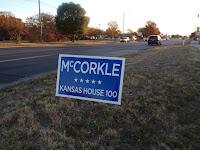 At the Great Plains Political Science Association annual conference held last weekend at Wichita State University, four political observers--three of them Insight Kansas contributors--were asked to make their predictions for next week’s elections. All four said they believed Sharice Davids would win re-election in the Third Congressional District; three out of the four said they believed Governor Laura Kelly would defeat Derek Schmidt and be re-elected; and two out of the four said they believed Chris Mann would defeat Kris Kobach and be elected Kansas’s attorney general. But further down the ballot, and pretty much everywhere else besides, maybe, the 3rd District and Kansas's northeast corner? The agreement was near unanimous (and in line with the latest public opinion analysis): November 8 will likely be a red wave, terrible night for the Democrats.
At the Great Plains Political Science Association annual conference held last weekend at Wichita State University, four political observers--three of them Insight Kansas contributors--were asked to make their predictions for next week’s elections. All four said they believed Sharice Davids would win re-election in the Third Congressional District; three out of the four said they believed Governor Laura Kelly would defeat Derek Schmidt and be re-elected; and two out of the four said they believed Chris Mann would defeat Kris Kobach and be elected Kansas’s attorney general. But further down the ballot, and pretty much everywhere else besides, maybe, the 3rd District and Kansas's northeast corner? The agreement was near unanimous (and in line with the latest public opinion analysis): November 8 will likely be a red wave, terrible night for the Democrats.“Near unanimous,” of course, means at least one voice of dissent. The dissenter was me.
Am I totally confident in my belief that Kansas, come November 8, may provide national Democrats with some tiny, consoling blue ripples during an otherwise rough night (which, on the macro level, I agree it will be)? Not remotely. So why bother saying so, when the usual political science variables—a midterm election during the first term of an unpopular President at a time of high inflation—point towards a Democratic bloodbath?
Maybe it’s just contrariness. Or maybe it’s the lesson of two elections. Or maybe, once again, it's the yard signs.
The first election I’m thinking is the one we just had: the August primary vote on the “Value Them Both” amendment. That the size of the victory enjoyed by abortion-rights supporters has been much commented on—but more relevant here is just how much of a surprise it was.There had never really been a vote like that one before: a straight-up, yes-or-no vote regarding the right to at least minimal abortion services. Frankly, no one really had any data to work with. Reasonable guesses could be made on the basis of demographics or party affiliation—but no serious observer could have guessed that the amendment would lose by nearly 20 points (I certainly didn't).
The 2016 election of Donald Trump similarly took a huge number of people by surprise—but in that case, the surprise wasn’t because of the lack of data, but because so many people (myself included) didn’t take seriously all the relevant information—the unpopularity of Hillary Clinton, the shifts in white voting patterns in upper Midwestern states, etc.—which pointed to the real chance that Trump could win. It seemed to so many of us just so unlikely and bizarre that we discounted it.
So we come to the Kansas 2022 elections, where we’re not in the same situation as before the August amendment vote. In fact, thanks to that vote, the Kansas Speaks survey, and some other data points, we know a fair amount, particularly about high levels of voter engagement among Democratic-leaning groups, and the early numbers which suggest that engagement may be continuing into the week of the election. We also know that Kelly’s approval numbers are pretty good, and that abortion, along with Medicaid expansion and medical marijuana legalization, are motivating many voters--presumably in a Democratic direction.
But are they motivating enough voters to entirely overcome the huge, historical advantages which Republicans enjoy in Kansas? Or all the other already-mentioned disadvantages weighing down Democrats this year? Probably not.
But in this election I don’t want to discount the data out there, however limited it may be. Yes, the election fundamentals and the polling (as flawed as much of it may be) suggest fairly comprehensive Republican gains, both across the nation and here in Kansas as well. Nonetheless, I believe there really is a chance that not only will we see some top of the ballot Democrats winning in this state, but also see enough Democrats holding on to or flipping state houses races—perhaps in Manhattan, Shawnee, Emporia, Hays, Hutchinson, or even here in thoroughly polarized Wichita—such that the Republican super-majority in Topeka could actually be lost, bizarre as that may sound in the wake the Republican redistricting of state and congressional legislative districts earlier this year.

Again, I’m not remotely confident about any of this. All the macro level stuff I mentioned above remains true--and frankly, the smart money is to always bet on what the macro trends say. But after 2016 and 2022, I’m not so confident as to discount the possibility of the truly unlikely happening either. I mean, what's the worst that can happen--I get it all wrong? I've eaten crow before, I can do it again.
